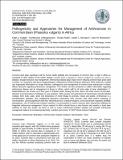| dc.description.abstract | Common bean plays significant role for human health globally and consumption of common bean is high in Africa as
compared to other regions of the world. Despite common bean’s potential in Africa, productivity remains low due to
diseases, drought and poor crop management. Anthracnose disease plays major role in reducing common bean grain yield
in Africa. It is caused by seed-borne fungal pathogen Colletotrichum lindemuthianum leading to 100% yield loss. Limited
and fragmented information on fungal infection, pathogenicity and management of common bean anthracnose in Africa
affects decisions regarding anthracnose management. This review has been produced to collect information regarding
anthracnose disease and its management in beans in Africa, which will be of great value to bean stakeholders. C.
lindemuthianum can survive up to five years in infected seeds. During this time, seed is the main source of inoculum,
infection and transmission of pathogen to new locations. Other sources and mechanisms of transmission include infected
residues, farm tools, water, wind, and disturbance of moist foliage by animals, insects and people. Anthracnose is a
hemibiotrophic pathogen, first establishing biotrophic interactions with common bean plant before switching to
necrotrophism, causing significant yield loss. Mechanical force, chemical weapons, toxins and growth regulators facilitate
pathogenesis. Use of anthracnose-resistant varieties is recommended to control common bean anthracnose followed by
integrated anthracnose management. Future research in Africa should focus on why farmers rely heavily on local bean
cultivars as seed and should use tricot as tool to screen anthracnose-resistant varieties and evaluate anthracnose
management options for increased productivity, nutrition and income. | en_US |

